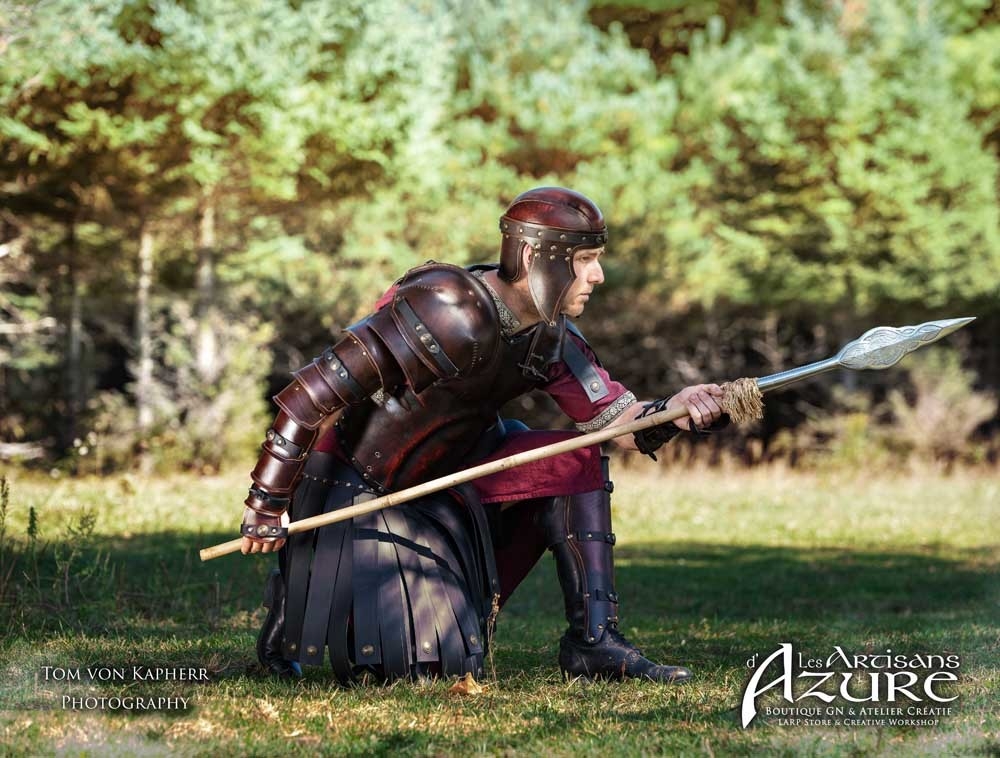What are the Different Types of LARP Armor?
What are the different types of LARP armor?
Armors are an integral part of medieval fantasy aesthetics, and had been almost universally used by soldiers and warriors of ancient history, from Antiquity to the Middle ages and deep in the Renaissance. In LARP, historical designs compete with fantasy armors, from leather armors to outlandish plate armors inspired by video games and movies.
A character's armor often offers in-game advantages in combat, providing more hit points or more resilience on the battlefield, but these accessories are more than stat enhancers, they are an integral part of a character's costume and can be used to enhance a particular look, to evoke an idea through the armor worn by the character.
LARP Armor Types
|
An armor is composed of various pieces, each protecting a specific part of the body, a limb, or as small an area as a knee or elbow. In LARP, armors are divided first by the area they cover, then by the material used. Let's get a closer look a the various pieces that compose a full set of armor. |
Body Armors
At the center of any armor set are body armors, such as breastplates, chain shirts, scale mails, gambesons, brigandines, and coats of plates. in LARP, these are the largest and most important armor pieces in many events, especially when the combat rules calculate hit points for the whole body instead of a limb by limb system. Body armors cover the torso, sometimes going around the back, or only protecting the front of the body.
Some heavier armors such as chainmails, plate armors, and coat of plates are more comfortable when combined with some light padding underneath, generally under the form of a gambeson, or padded armor. Sometimes, a thick tunic can suffice.
Another aspect that makes body armor uniquely important is that they often support various other armor pieces, pauldrons, armored arms, tassets and legs armor being often affixed on the body armor. When buying one, it is often a good idea to see if the armor is compatible with other armor pieces you may want to attach to it.
Examples of LARP body armor:

Helmets
Helmets were always one of the first armor piece acquired by soldiers for the historical battlefields, as any hit to the head was likely to be fatal. In LARP, helmets aren't as vital, with the exception of more sportive events like Bicolline, where head strikes are allowed in combat. However, if the protective aspect of helmets isn't as important, there is few better ways to give a character a decisive martial look than to add an helmet to their costume.
Examples of LARP helmets:

Arms
Arms' armor includes pauldrons, bracers, gauntlets, articulated arms, and elbow protection. Partial arm protection is easy to achieve with a few armor items, simply using bracers or fixing pauldrons on a breastplate, gorget, or harness is an easy way to increase a character's armor and accessorize in the same move.
In combat, the arms are a prime target for opponents, each of your attacks providing the opportunity for a counter strike aimed at the hands and arms. For this reason, the arms are often the first limbs to get protection.
Armor bracers, especially the leather ones, are also an iconic part of the medieval fantasy look. even for many non-combatant characters.
Examples of armor for arms:
- ➼ Leather Bracers
- ➼ Plate Bracers
- ➼ Leather Pauldrons
- ➼ Plate Pauldrons
- ➼ Gorgets
- ➼ Full Arms & Elbows
Leg Armors
Often the last part of the body to receive attention when its time to gear up, the legs are nevertheless important to protect, and have been for a long time. Armored skirts and greaves were widely used during Antiquity, and tassets protecting the thighs have been an integral part of heavy armors in countless cultures, including the famous gothic full plate that is probably still the most iconic of medieval armors.
Leg protection in LARP makes you harder to take down, and serves to balance the too often top heavy armor gear that is seen on many battlefields. Tassets and armored skirts in particular elongate the torso and give a much more elegant finish to many armor sets when compared with a lonely breastplate.
Examples of leg armors:

What materials are used to make LARP armor?
LeatherLeather armors are particularly associated with fantasy, with little to no historical counterparts. Often considered as light armor, they can vary a lot in style, this material being both the most basic one for young LARPers, but also the one used for the most intricate and detailed armors you can find. Basic leather armors are often made of processed leather, which we call buffalo leather at Les Artisans d'Azure. This type of leather is sturdy and durable, but cannot be stamped, dyed, or decorated much. Its the best leather for plain armors, and any armor part that needs to focus on resilience, like straps for instance. It's also often cheaper, since it requires less work to craft from this material. Vegetable leather, which is made of animal hides treated with plant based compounds, offers a lot more options for the artisan, and can be extensively decorated with stamp tools, engravings, custom dyes, paint, and varnish. It's often used for more intricate armor design, and is more rigid than processed leather. Vegetable leather requires more care and maintenance, but can be worked to create truly stunning results, far more detailed than any other armor type. TextileOne of the most common historical armor types, the gambeson or padded armor was made out of thick linen or cotton layers, and could stop or mitigate the damages of many weapons. It was also combined with chain and plate armor as a secondary layer for comfort and protection against blunt impacts. In LARP, gambeson isn't always considered armor in terms of combat system or providing extra hit points, but it is an historical oversight if you ask us. Modern gambeson often used synthetic materials like polyester, but the higher quality ones are often still made of linen and cotton. ChainChain was popular from the late Antiquity until far into the Middle Ages, with some places like India still using it centuries after the end of the medieval era. It is flexible, provides great protection, and excellent mobility compared to more rigid armors, the only compromises being the weight and the vulnerability to blunt impacts. Chainmail is heavy, and without some padding and a good belt to hold it in place around the waist, it can be intense to wear it in combat. Modern chain exists in butted form, which is often cheaper and lighter, and riveted form, which is more historically accurate and sturdier. Aluminum chain also has a lot of popularity in LARP, being very light and still looking quite knightly despite the modern material. Aluminium also doesn't rust, which is very appreciated by LARP enthusiasts. PlateThe epitome of medieval armor in most people's mind, plate armor was in fact a pretty late addition to the equipment of knights and medieval warriors. The famous full plate armor was developed in the Late Middle Ages and the 14th century, but is more a creature of the Renaissance, knowing the peak of its popularity between the 15th and 16th centuries. Plate armor pieces were however very accessible to men-at-arms and knights during the end of the medieval period, even if full armor sets were rarer. The advantages of plate are many, as it is the most advanced form of armor, almost immune to slashing and piercing attacks, which causes it to provide the best bonuses in LARP combat. Plate needs to be better fitted than other armor types, for a too loose or too tight armor may hurt in action, unless a gambeson is added to provide some padding. In LARP, plate armor is generally built of lighter and cheaper metal than needed for real historical combat, very few artisan bothered to harden the steel like in the old days. It is often made of soft steel, which looks the most authentic, but can rust, stainless steel, which is rust proof but prone to scratching, or aluminum, which is lighter, rust proof, but less authentic looking. CompositeSome armor doesn't quite fit in more well defined categories. Armors like scalemail and lamellar armor, made of multiple tiny pieces of metal, are often considered as chainmail equivalent in LARP, but are quite distinct with their own particularities and historical origins. More complicated is the case of coats of plate, brigandines, or jacks of plate, which are made of large interlocked plates of steel riveted inside a leather or cloth outer layer. Precursor and contemporary to plate armors, this form of composite armor was very widespread, but is often misidentified as ''studded leather'', while it is more akin to plate armor in practice. |

Where to buy LARP armor?
You can find all sorts of LARP armor and accessories at our store from various big names in the LARP world. Les Artisans d'Azure are also armor makers themselves, with our own fantasy armor sets, historical reproductions, and more. We specialize in leather armors, gambesons, and coat of plates, even offering a custom service.






Leave a comment